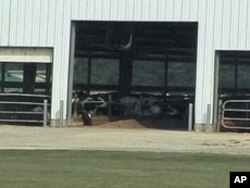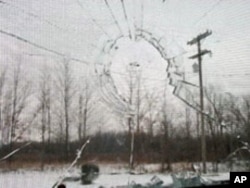Lynn Henning samples the waters for pollution from the large livestock farms near her home in rural Michigan. But it's not her job.
"I have no chemistry background. I'm a farm wife," she says.
Henning and her husband grow maize and soybeans on their 120 hectare farm.
Factory farm pollution
But within 16 kilometers of her home live tens of thousands of cows and hogs in what are called concentrated animal feeding operations, or CAFOs.
Most of the milk, pork, chicken, and beef in the United States comes from the large factory farms that raise thousands of animals in enclosed barns. But that efficiency is coming at a cost to the environment.
The several hundred animals housed in each medium-sized CAFO produce as much waste as a small city of tens of thousands of people.
But, unlike city sewage, this waste sits in lagoons and is spread untreated on farm fields as fertilizer. Henning says the smell can be overpowering.
"It's putrid," she says. "You can't hang laundry. You have fly infestations. You have rat infestations. You can't go outside. And you can't open your windows."
The waste can also pollute the water when it runs off into streams or overflows the lagoons.
That's what happened in 2000. Someone reported pollution from one of the CAFOs to state authorities and the CAFO operator blamed Henning.
Ironically, she had not gone to the authorities that time. But the incident got her interested. So she did some research.
Taking matters into her own hands
"We started investigating and doing water samples and found that we had a horrendous problem."
Henning says state and federal agencies don't have the funds to monitor CAFOs, so she taught herself how to do it. Working with the Michigan chapter of the environmental group the Sierra Club, she now presents state authorities with data several times a week along a 200-kilometer circuit.
"So we are the eyes and ears of the community," she says. "And with our help, by documenting and having credible information and scientific data, we can help them do their job better."
High personal cost
As a result of Henning's work, the state has cited CAFOs for violations hundreds of times. That has made her the target of harassment.
"We got chased down back roads. We've been chased to the sheriff's department. I've been trapped by manure semis on back road[s]," she says. "I've had dead animals on my mailbox, on my car, on my porch. We've had our mailbox blown up. And recently, my two-year-old granddaughter's bedroom window was shot out."
But her efforts have been rewarded. Henning recently won the Goldman Prize, the world's largest award for grassroots environmental work. She has donated the $150,000 prize to nonprofit organizations so others can keep a close eye on pollution from livestock waste in their communities.















